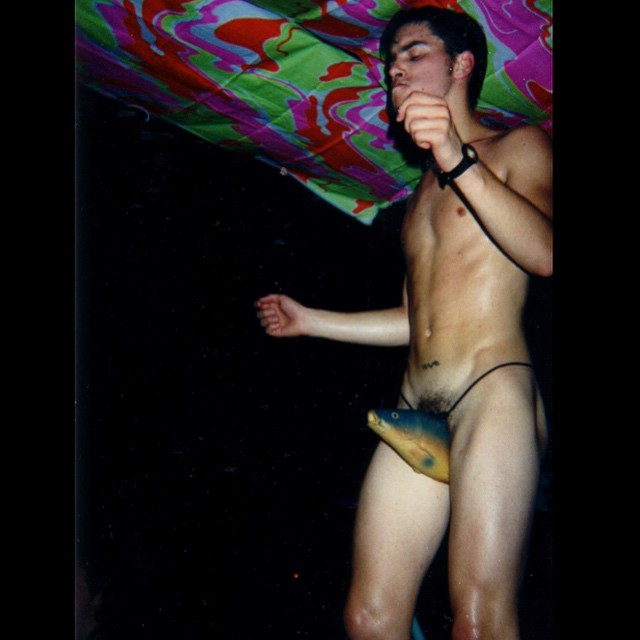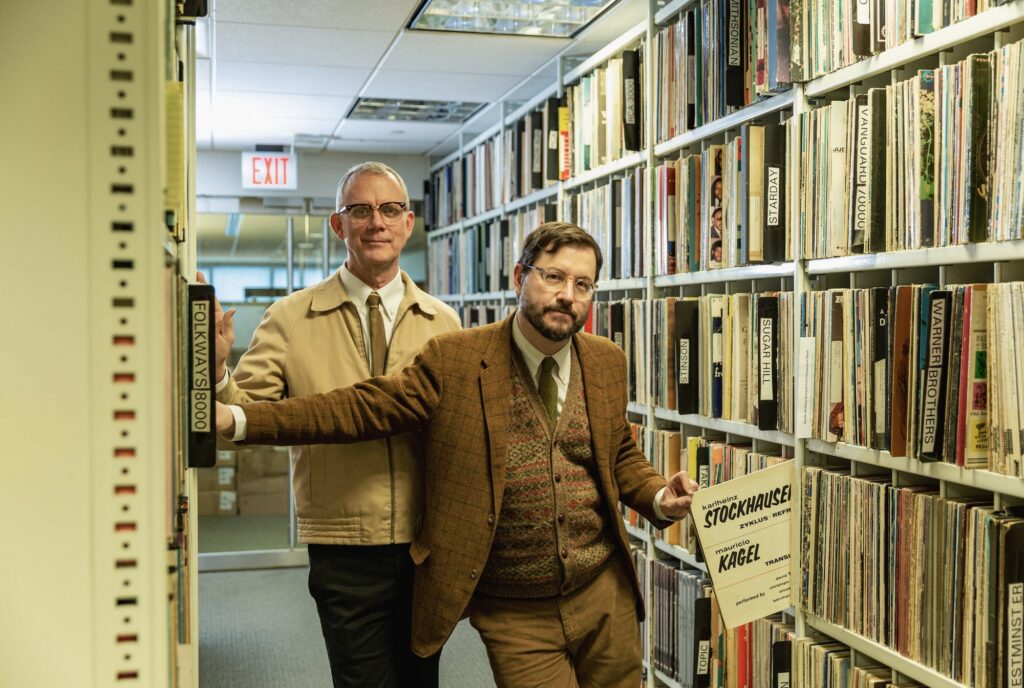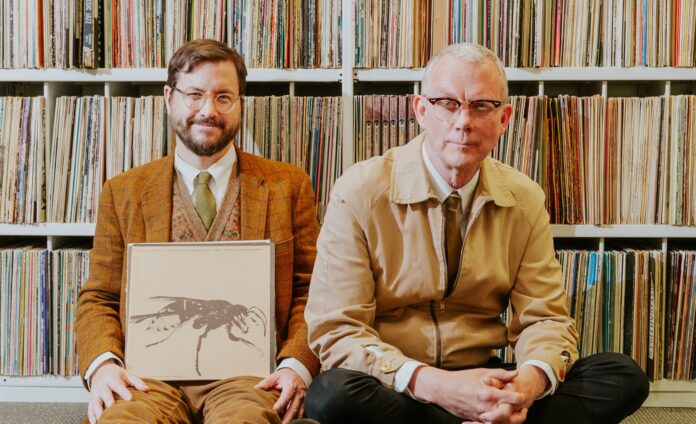Dr. Drew Daniel can barely distinguish between his professional and personal life.
As one half of Matmos—the experimental electronic group he formed in San Francisco with life partner Martin Schmidt (M.C. Schmidt)—the lines between work and play often blur.
“It’s always been a band, a relationship, and a lifelong collage,” says Daniel over the phone, while driving to San Francisco for their show at Great American Music Hall last Saturday. That esteemed venue is just blocks from the Tenderloin apartment where the pair began their musical and romantic journey in the early ‘90s.
The now Baltimore-based duo (both professors at Johns Hopkins University) first made noise with their debut cassette, 1994’s In Lo-Fidelity, a collage of humorous, thought-provoking, and ridiculous cut-up sounds pieced together to make each other laugh.
They’ve since incorporated samples from recordings of the amplified nerve tissue of crayfish, contact microphones on human hair, frozen water thawing, “snails interrupting the path of a laser and altering the pitch of a light-sensitive theremin,” and their washing machine—over 13 additional albums.
Their latest, 2023’s Return to Archive, is a commissioned collection of compositions relying on non-music material sourced from Smithsonian Folkways to commemorate the prestigious label’s 75th anniversary.
Matmos has also collaborated with The Kronos Quartet, Yo La Tengo, and Björk, remixing the Icelandic artist’s 1997 single “Alarm Call” and working with the singer on her Vespertine (2001) and Medúlla (2004) albums, and scored John Cameron Mitchell’s 2017 sci-fi rom-com How to Talk to Girls at Parties. Daniel also fronts the experimental house music project The Soft Pink Truth.
With the 30th anniversary of In Lo-Fidelity, it seemed like the perfect time to return to the scene of the crime, and, aided by Daniel and Schmidt, reflect on Matmos’ formation, the early shows, and why San Francisco was the perfect “proving ground” to realize their potential.
Help us save local journalism!
Every tax-deductible donation helps us grow to cover the issues that mean the most to our community. Become a 48 Hills Hero and support the only daily progressive news source in the Bay Area.
48 HILLS Let’s go back in time. How did you end up in San Francisco?
DREW DANIEL Martin was born in Burlingame in 1964 and grew up in Burlingame, Monterey, and Walnut Creek before coming to San Francisco.
He lived in a noise warehouse called 455 10th Street in the South of Market area, which hosted classic noise bands like Big City Orchestra, The Haters, Cement, Crash Worship, and The Seamen. Great musicians like Kris Force from Amber Asylum and David Gardner from Tipsy also lived there.
He had a bunch of synths and lived like a vampire. He would get up at 3 pm and stay up all night, drinking at The Stud and hanging in the queer scene, and then go to sleep when the sun came up. But he lived in the Castro when we started canoodling.
I came to the Bay in ‘89 as an undergrad to study philosophy and English at UC Berkeley. Go Bears! I lived in Berkeley and then moved with Martin into the Tenderloin.
We lived at Geary and Larkin, right around the corner from The Magazine. The Tenderloin was the epicenter of where Matmos got going. I saw so many bands at the Great American Music Hall and we also opened for Wire and Godspeed You! Black Emperor there. Then we eventually moved to the Mission.
48 HILLS How did you two meet?
DREW DANIEL We met when I was go-go dancing at Michael Blue and Lewis Walden’s Club Uranus at The EndUp. Blue and Walden were DJing at these incredible queer spaces. It was those spaces that brought Martin and me together.

48 HILLS There’s that famous photo of you go-go dancing in a jockstrap connected to a plastic fish.
DREW DANIEL Yeah, I tucked my junk into the fish’s mouth and then the tail came out my ass. Like the song from Gypsy says, “You Gotta Get a Gimmick.” Mine was unusual—plastic jockstraps. I had a Joe Camel jockstrap and a baby head jockstrap. Everything at Club Uranus was so cranked up with the standard set by Jerome Caja. So I was having fun with it.
However, there were some wardrobe malfunction moments. I had some g-strings fly off, and suddenly—I was naked and flaccid in front of a room full of judgmental gay men. I was also 18 at the time but I had a fake ID. So that was a fun adventure.
48 HILLS Between Phatima, Bambi Lake, and Heklina‘s deaths, the Verasphere movie, Fauxnique’s memoir, K.M. Soehnlein’s latest book, and the forthcoming Pippi Lovestocking and Jerome Caja documentaries (not to mention the reopening of the Stud itself), there’s been a resurgence of interest in that era. What makes it so compelling?
DREW DANIEL There was a creative, anarchic, and funny spirit—a dialectical response to the tragedy of AIDS: so many people dying and so many experiencing the oppressive political situation around AIDS. So it was weird that the pushback involved so many hilarious people: The Popstitutes’ Diet Popstitute, Tyler Popstitute, and Remix von Popstitute (Alvin Orloff), as well as artists like Miss Kitty and Jerome. They were not doom and gloom. These are witty and thoughtful people down to create something weird outside of mainstream gay culture.
I felt lucky to DJ at Klubstitute because of the weirdly themed parties. It fed into Trannyshack and later iterations of the same idea. That willingness to rewrite the rules made it special.
Uranus would have techno, Public Enemy, and James Brown playing, but they would also have Crash Worship or Millions of Dead Cops performing. It was farther out in terms of what the parameters were.
48 HILLS The downside was the losses.
DREW DANIEL We lost a lot of people in that scene. It was terrible. The wave of losses started with Jerome, Miss Kitty, and Diet and cascaded on. But I’m glad people are archiving. There is a Facebook group where people share pictures from that era.
48 HILLS How did you and Martin decide to start a band?
DREW DANIEL Well, Martin made the first move. I had seen him at 924 Gilman. He was in a band that made fucked-up industrial music. Everybody looked very satanic and edgy, and then Martin looked like this charming time traveler from the ‘60s, like Darrin from “Bewitched.” So I was intrigued.
But he was the one who said, “Hey, do you want to come to my apartment? I have a computer where we can edit audio.” And that was a big come-on because this was not easy to do then. So Martin got my attention quickly with that offer.
MARTIN SCHMIDT It was computer love. [Laughs]
DREW DANIEL We went to his apartment and made collages of ridiculous sounds. It was technically pretty primitive—eight-bit mono audio using Macromedia SoundEdit. But it was so fun to sit together and take turns making sounds. Then we’d play it back, and it was fucking amazing. So it’s always been like a band, a relationship, and a lifelong collage. It’s all one.
48 HILLS Do you remember your first show?
DREW DANIEL Our first show, in the early ‘90s, may have been at a warehouse called Aunt Clara owned by our friend David Jude Thomas. But Klubstitute people came to the Aunt Clara house, and we performed in the studio, pumped the sound out to speakers, and people listened from tents outside. So it was a little bit of a camping-in-the-city weirdo ambient rave.
48 HILLS People still talk about your 2004 Yerba Buena Center for the Arts show that was 97 hours long. What is your most memorable Matmos performance in San Francisco?
DREW DANIEL My vote for that would be when we played at the San Francisco Art Institute, outside in this courtyard, around 2006, the time of The Rose Has Teeth in the Mouth of a Beast LP. We had a cow uterus, which we inserted a vacuum cleaner into and inflated, and then tried to play it like a bagpipe because that’s how we had made the Valerie Solanas piece, “Tract,” for that album.
But the uterus had a hole in it and deflated—and it just smelled horrible and didn’t make a good sound, but it was fucking weird and abject. So I remember that as a moment of interesting, disgusting failure.
Then we had a bunch of musicians with us drumming with roses on the metal railing above as we played “Roses and Teeth for Ludwig Wittgenstein.” I remember this cascade of rose petals falling. It smelled so beautiful, especially after the disgusting cow uterus. So that was the Matmos concert with the most extreme range of smells. Yeah, I like that one quite a lot.

48 HILLS In what way is San Francisco the third member of Matmos?
DREW DANIEL San Francisco is the proving ground for us to figure out what we could do as a band. When we played the first time at Yerba Buena before the Work Work Work exhibit, we did a one-off show that the curator, Arnold Kemp, set up for us. I remember we were inflating a giant weather balloon, and then we floated a speaker to the ceiling. It was fun to send sound through space.
Then, when Björk asked us to tour and open for her, we did that every night. So an idea that began at the Yerba Buena Center then became something we did at Radio City Music Hall and in all these worldwide spaces.
48 HILLS How hard was it for you to leave San Francisco for Baltimore?
DREW DANIEL It was scary. It’s all a testament to Martin being incredibly loving and patient with me, that he was willing to leave his job at The Art Institute teaching video art so that I could be an English professor. I didn’t know anything about Baltimore. It was a total crapshoot, but we found a great community of experimental musicians and instrument builders.
It was hard to say goodbye to all our friends and family; my mom lives in Half Moon Bay and my brother lives in Oakland. It was our whole context so it was pretty wrenching. There are things you just can’t replace. You can have change, but people are irreplaceable.
I couldn’t lead the double life if I didn’t have Martin helping so much, so I could focus on being a Shakespeare professor when necessary. It is tricky trying to do the Jekyll and Hyde thing. I’m getting older now. I’m 52 and Martin’s 59 but we just stay on it. The fun part is I love being a professor and making music, so I just have too much fun shit-packed into a given week.





